How Could Jesus and St. Peter Speak to 5,000 People at Once?
Successfully addressing large crowds is not impossible at all, and history itself attests to this.

The Gospel of Mark (4:1-2) says, “Again Jesus began to teach beside the sea. And a very large crowd gathered about him, so that he got into a boat and sat in it on the sea; and the whole crowd was beside the sea on the land.”
And Acts Chapter 2 says, “The multitude came together. … Peter lifted up his voice and addressed them. … So those who received his word were baptized, and there were added that day about three thousand souls.”
Some skeptical Bible scholars and Bible critics have argued that it was impossible for Jesus and St. Peter to address thousands of people without a microphone. In fact, successfully addressing 5,000 people or even many more is not impossible at all, and history itself attests to this.
But we’ll assume for a second that all reports of such speeches were exaggerations or outright falsehoods. What does science tell us? It’s reported that Protestant evangelist George Whitefield (1714-1770) preached to crowds of 20,000 or more as a young man (up till about 1739). Those who heard him said he had a voice “like a lion.” Benjamin Franklin actually did an experiment in that same year to test Whitefield’s range.
Braxton Boren, who was in 2014 a doctoral candidate at the Music and Audio Research Laboratory at New York University, did an “updated Franklin” study. His specialty is the physics of sound and acoustic simulation techniques. In a separate interview, readers were informed of what he discovered. Using a variety of variables, the loudness of Whitefield’s voice was estimated to be an amazing 90 decibels (usually, what is considered “loud” is 74 or more, and normal conversation is 60). Actors and opera singers were enlisted to test voice loudness, and the highest they could attain was, sure enough, around 90 decibels.
The study concluded that Whitefield could be heard in an area of 25,000 to 30,000 square meters, in “optimal conditions.” That would be as many as 50,000 people. Certainly 20,000-30,000 could easily hear him. Moreover, buildings in the surroundings add some six decibels to the loudness of a voice. That was the case in Jerusalem with Peter. So could Peter have talked to more than 5,000? No problem at all, according to acoustic science. All he needed was a loud voice. Paul (who is recorded giving many speeches and sermons in the New Testament) was said to have a “loud voice” also (Acts 14:10; 16:28). Peter isn’t described in this way, but it’s a reasonable assumption to make.
Another factor in public speaking to large crowds (minus microphones) is the topography of an environment. The tour guide when my wife Judy and I visited Israel in 2014 explained how Jesus probably gave the Sermon on the Mount from the bottom of the mountain. The hills at the spot form a natural amphitheater which allows easy hearing. Sound projects upward and is “caught” by the amphitheater shape (precisely why the ancient Greeks and others used that design). Our guide said that he has visited the Church of the Beatitudes at night with no one around, and could clearly hear fishermen talking down by the sea.
Our tour group later tested the theory in a similar “amphitheater” location where he fed the 4,000 (across the Sea of Galilee). It was absolutely true: we could hear each other (talking fairly softly, to test it) perfectly from bottom-to-top and vice versa.
Jesus is described five times as having a “loud voice” — even on the cross (Matthew 27:46, 50; Mark 15:34; Luke 23:46; John 11:43). Besides the Sermon on the Mount, he is described in other instances as preaching from a boat in the Sea of Galilee (Matthew 13:1-9; Mark 4:1-9), which generally has large slopes by its shore. He spoke to “great crowds (Matthew 13:2), “a very large crowd” (Mark 4:1), “a great crowd” (Luke 8:4) and “a great multitude” (Luke 6:17). If he had a loud voice and the acoustics were right, He could have easily spoken to many thousands. Lay archaeologist B. Cobbey Crisler and professional sound engineer Mark Miles tested this very thing in the same spots on the Sea of Galilee and got precisely the same results.
Back to St. Peter: when he spoke on the Day of Pentecost (Acts 2), and 3,000 people got baptized and joined the Church, the location (the Upper Room, near the present tomb of David) was the present-day Mt. Zion, a western hill of Jerusalem. So he could have (quite possibly) been preaching to crowds down the hill from Mt. Zion (see a photograph of it): where the Day of Pentecost and the receiving of the Holy Spirit took place (after which he spoke). That would make it easier to be heard, and if indeed he had a loud voice, too, all the more so. The second speech to a large group by Peter was in the Temple complex (Acts 3:1-2, 11-12). As noted above, buildings or walls increase the loudness of one’s voice, and the crowd would have been more compact.
- Keywords:
- apologetics

















